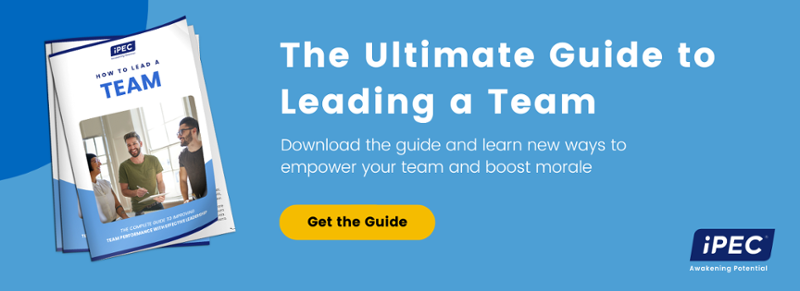A Guide to Establishing Personal Development Goals for Work
by iPEC Team
Jun 15, 2022 | 6 minutes read
We all have aspirations for the future—for who we want to become and what we want to accomplish as we grow throughout our personal and professional lives.
Setting goals is a great way to stay on the path toward where you want to be and track your progress over time, both at work and in your personal life. Goals act as mile markers that can add specificity and excitement to your vision for the future—goals can also help you identify strengths you want to build upon and challenges to overcome.
And yet, setting goals (and sticking to them!) can also be a challenge. If you’ve struggled to stick with and stay accountable to your goals in the past, you’re not alone!
We’ve all experienced the frustration of setting goals and struggling to achieve them for one reason or another. And regardless of what you thought or how you felt at the time, we’re here to reassure you that the problem was not you—it was with the goals themselves.
A goal that feels unrealistic or too ambitious can leave you feeling unmotivated or defeated. At the same time, setting the bar too low might not feel inspiring for you. A key aspect of successful goal-setting is balancing ambition and attainability, so you can stretch yourself and experience growth without overwhelming or burning yourself out in the process.
Luckily, there’s a framework you can use that’ll help you find your own sweet spot, and set goals that feel both attainable and motivating to you.
Let’s take a look at some steps that’ll guide you in setting and achieving your personal development goals for work, using the AIM SMART goals methodology to help lead the way.
Step 1: Take Stock to Find Your Vision
The first step to achieving your professional goals is simple: pause and really get curious and clear about who you are, who you want to be, and what you want to accomplish in your career.
Start by taking stock of where you are today. A pen to paper journal or digital notepad both work great—we won’t judge! But take time to reflect and answer these questions.
- How happy or fulfilled do you feel in your career?
- Where are you in your professional journey, compared to where a younger version of you might’ve imagined you’d be—and how do you feel about that?
- What are some of your strongest interests and strengths, and how are they showing up in your professional life?
- Where do you feel most proficient, and where might you have room to grow?
Creating your vision for the future is so important! Using your answers to the questions above as guideposts, you can start to fill in the gaps and envision the type of future you want to start moving toward.
Going through a reflection process like this will give you a clear, inspiring vision to strive for throughout all the peaks and valleys of your journey. The vision will always be there to keep you on track.
Step 2: Develop Your Plan
Your vision almost certainly won’t become reality overnight—and that’s okay! Most visions or goals worth pursuing are going to take some time and effort. You’re more than capable of getting there with a mix of patience, persistence, and accountability to support you.
To start, we recommend getting really clear about the steps it will take to reach your vision. Dividing a larger goal into smaller, more manageable steps makes accomplishing it feel much more possible—and the SMART goal methodology is a great place to start.
SMART stands for specific, measurable, attainable, relevant, and time-bound. Using the SMART framework makes achieving your goals easier by breaking them down into smaller steps, while experiencing the momentum for progressing from step-to-step helps you stay motivated to keep going.
SMART goals have other benefits too! They can:
- Create a clear vision of your objectives and of how to achieve them
- Increase motivation and improve performance
- Improve time management
- Help monitor progress
Let’s take a quick look at the thinking and value behind each of the five components of SMART goals.
Specific
Your personal development goals for work should be as specific as possible. A goal as simple and vague as “become a better leader” leaves a lot of room for interpretation, and no clear finish line to know when you achieved it. Instead, you might focus on one specific area of your leadership abilities you’re most interested in developing and make that the target of your goal-setting.
For example: “Strengthen my communication skills as a leader” is a more specific goal than, “Become a better leader.”
Measurable
A measurable goal equals measurable success. If there’s no marker to help you measure your progress, you’ll have a hard time determining whether you’re moving toward your goal or if something needs to change.
Using the same example from above of improving your communication skills as a leader, you might make that measurable by adjusting that goal to something like, “Earn a leadership certification focused on communication.”
Attainable
For your goals to be attainable, they need to be (and feel) realistic for you. Think about that balance we talked about in the opening section. If you’ve never earned a leadership or coaching certification before, setting a goal to earn three accredited certifications in a week might be too lofty. If you have earned one or two such certifications in the past, expanding to a third, fourth, or fifth within a reasonable timeline becomes much more realistic.
Relevant
It’s also a good idea to make sure your goals align with your other personal or professional objectives (and/or possibly those of your organization.) If communication isn’t something that supports some of your other goals, you might decide to focus on another area instead, like enhancing your productivity or professional relationships.
Time-bound
The timing and deadline of your goals should be set with intentionality. As we touched on earlier, you probably shouldn’t expect to jump from zero certifications to three in the course of a week or two. Instead, ask yourself: what would be a reasonable amount of time in which to try and achieve this goal? Maybe it’s a few months, or even up to a year. It’s important to give yourself the time you need to truly dedicate yourself to your goal and to take the steps needed to achieve it.
—
At iPEC, there’s an additional layer we teach inside our Coach Training Program to further enhance the goal setting process, by which SMART goals become AIM SMART goals. Using the AIM SMART framework will help ensure the goals you set are realistic, and don’t feel too overwhelming.
Once you’ve zeroed in on a goal using the SMART framework, turn that goal into an AIM SMART plan by asking yourself the three questions below:
Acceptable Minimum
What is the Acceptable minimum (the least you can do) to move forward?
Ideal
What is the Ideal (the most you can do) to move forward?
Middle
What is the Middle (a reasonable stretch goal for you at this time) to move forward?
(Psst! We know getting buy-in from leadership to dedicate the time and money toward leadership or coach training can be a difficult subject to navigate. If you could use some support, check out these tips on how to ask your boss for time (and money) to attend coach training.)
Step 3: Track Your Progress
Once you have your SMART plan, we suggest documenting it somewhere and making it visible in some way! That could mean printing them out and pinning them near your desk, adding them to their own project inside your task management system, or even setting them as your desktop background. This can help you keep them top-of-mind and remember to track your progress.
Not to mention, recording your progress over time can help you uncover patterns and personal best practices that’ll support you in achieving your goals. Whether you prefer digital or analog tools, there are tons of options you can use to monitor your progress easily and efficiently. Give yourself permission to experiment with a few and see what works for you!
Step 4: Check In on Your Progress Regularly
Now that you have a clear vision, a SMART goal, and a broken down roadmap to help you get there, it’s important to make time to check-in regularly with how things are going. How are things progressing? How have circumstances changed and to what extent does your plan still feel doable? What adjustments can you make?
Especially when you’re working toward longer-timeline goals, it can be easy to lose sight of the bigger vision or the deeper “why” for wanting to achieve it. Revisiting the initial plan and reconnecting with your goals can help either keep you aligned and committed to the journey, or it might highlight that it’s time to alter course in a slightly different direction. Either way, you’ll learn something valuable!
Set and Achieve Meaningful Goals With iPEC
Becoming a Certified Professional Coach is one of the most effective and actionable ways to become an agent of change within your workplace. Regardless of your role or your level of seniority, you have the power to affect meaningful change through formalized coach training—and iPEC is here to help you get there.
In becoming a Certified Professional Coach (CPC), you’ll be able to help both yourself and others become the most confident, self-reliant, and fulfilled version of themselves. Research also shows that HR professionals who became an iPEC Certified Professional Coach were promoted 14% more often than colleagues with no certifications, in addition to taking home 28% more pay.
Through expert training and support in mastering Core Energy Coaching™, you will open limitless opportunities for career growth and fulfillment—both in your own life and in the lives of those you work with every day.
Get the free guide, How to Lead a Team, and discover new ways to empower your team.
Inside you'll learn solutions to common challenges we hear from executives, managers, and leaders that'll help you improve team performance, discover your leadership style, and practice effective leadership through coaching.


